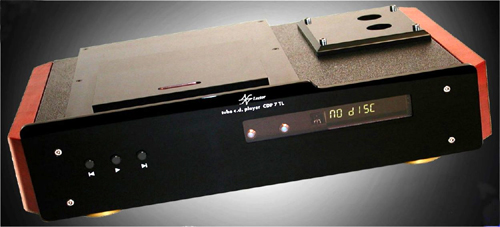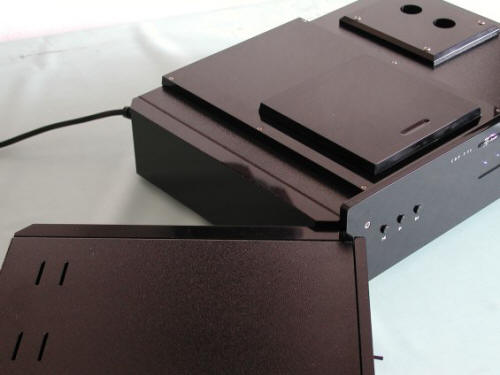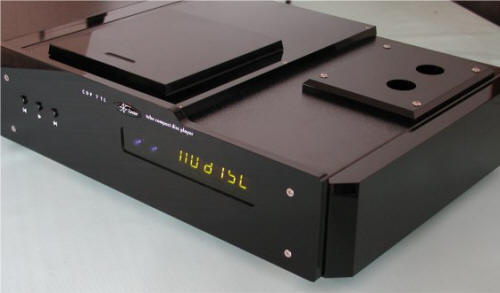
You are reading the older HTML site
Positive Feedback ISSUE
march/april 2007
lector
CDP-7T CD player
as reviewed by Rob Moores

|
ROB MOORE'S SYSTEM
LOUDSPEAKERS
ELECTRONICS
SOURCES
CABLES
|
After reading the review of the Lector CDP-7T CD player in The Absolute Sound, I became curious to hear this alleged giant-killer for myself, so I borrowed one from the UK distributor. When I think of Italian hi-fi, I picture exquisitely designed, beautifully constructed pieces of audio jewelry. The Lector certainly bucks that trend. Instead of Swiss-watch-type construction and attention to detail, this player gives the impression that it is hand made, in a small workshop, in a tiny village nestled in the Italian mountains. It looks simple at best, prosaic at worst.
What do you get for your £2000? Aside from the power cord, the remote, and the CD puck, there are two black boxes. The smaller of the two houses the power supply. The bigger box, which is around twice the size of the other, houses the transport, DAC, and valves. It is adorned with two slabs of wood, to give it an up market look. This practice of screwing half a forest to audio components seems to be exclusively Italian. There are sonic arguments for it—the wood will damp the chassis and make it more inert—but from an aesthetic point of view, it works in some cases, others not. In this case, it doesn't look too bad, but audiophiles are a shallow lot, and when the Lector player is compared, on looks alone, to the likes of Musical Fidelity or Cyrus, it doesn't stand a chance. There are very few dealers in the UK that sell the Lector, and it is not hard to tell why. Before you conclude that the Lector feels cheap, let me assure you that it doesn't. It feels solid and well put together, but it just doesn't look it. As they say, though, you should never judge a book by its cover.

CDs are loaded by sliding back a plastic door on the top of the machine, left of the transport. You place the CD on the spindle, then secure it with the magnetic puck. When you slide back the door, the player reads the information on the disc. On the front of the player is the simple display, which can easily be seen from around fifteen feet away. The display can be switched off, but this can only be done by accessing a toggle switch on the back of the transport. For some reason, this also disables the remote control. Strange. I tried the player with the display on and off, and could not detect enough difference to justify having to get up from my chair every time I want to choose a different track.
I placed the Lector on my Henley Designs glass-and-aluminum rack, and connected it to the Pathos Logos amplifier using Chord Cobra 3 interconnects. I did not use any isolation, nor did I feel the need to explore this avenue. This may be something worth experimenting with, but for review purposes, I listened to the Lector as it came out of the box.

I left a CD on repeat for a few days, then grabbed a few discs and settled down to listen. My first impression was that the player may look like it cost a hundred dollars, but it sounds like it cost a million. Well, perhaps not quite that much—even the highest of the high end doesn't reach those levels—but on initial exposure, the sound of this machine was shocking. I found myself looking incredulously at those unassuming black boxes as they produced a sound so beguiling, so ethereal in the midrange, so powerful in the bass, and so delicate in the treble, that I had trouble convincing myself that I was listening to a £2000 player.
The first thing that hit me was the low end. I certainly wasn't prepared for the quality and quantity of the bass that this player can produce. On previous listens to "Broken Wings" by Dougie Maclean, from his fantastic album, Marching Mystery, I had been aware that a bodrhan (an Irish frame drum) was providing a slow but insistent rhythm below Maclean's sublime acoustic guitar playing and singing. With the Lector, I became far more aware of this instrument. It was not obtrusive, but it now had a much grayer part in the song. Its powerful beat was urging the song onward, almost like a heartbeat. Every strike of the drum now had shape, impact, and most important, purpose. I was so taken by this that I didn't really focus on anything else, and needed to listen to the song again. Only with the shock of that bass performance behind me could I appreciate the other attributes of the Lector player.
Every detail of the plucked strings of Maclean's guitar, and every inflection of his voice, sounded like it was in the room, while a deep, wide soundstage expanded across the back wall. Everything was there to be heard, and not just on this recording. The Lector seems to be able to turn its hand to any type of music, without fuss or fanfare. I was able to enjoy disc after disc without the audiophile voices in my head questioning this or that element of the performance.
My own player is a Wadia 302, which sells in the UK for around double the price of the Lector. I have owned the Wadia for over a year, and have been more than happy with the sound. I use its balanced outputs into the balanced inputs on the Pathos amp, as this takes full advantage of the circuit topography of both units and is the best way to use them. The Lector does not have balanced outputs, so I could only use single-ended interconnects. In view of the cables that I had on hand, I had to use interconnects that were inferior to the ones that I use with the Wadia.
After playing quite a few discs on the Lector, I played several of them on the Wadia. I won't dissect each performance, but it was clear to me that the Lector was the better machine at half the price. The Wadia does everything it is supposed to do in hi-fi terms. Bass and detail retrieval, to name but two elements, are exemplary, but as I say, only in hi-fi terms. With the Wadia, I felt as I always have—that I was listening to different pieces of a musical jigsaw—and I had to make a conscious effort to relax and listen to the whole picture. This was not true of the Lector.
In material and aesthetic terms, the Lector comes across as a poor value. In the market at a similar price are players from Ayre, Linn, and Copland, to name but three. Each looks arguably better than the Lector, but beauty, as they say, is in the eye of the beholder. They also say that beauty is only skin deep, and this is where the Lector triumphs. In sonic terms, the Lector is in a different league, and in my opinion, that gives it great value for the money.
"Upgrading" is a word that appears everywhere, from magazine advertisements to reviewer diatribes about the next best thing. I feel that most changes to a system are merely that—changes—not necessarily better, just different. If different floats your boat, that's great, but must of us work hard to fund this hi-fi hobby, and in most households, the purchase of a £2000 CD player is well down on the list of priorities. However, if you can buy a £2000 player that gives better performance than a £4000 player, thoughts of upgrading are put to one side because you know that you will have to spend more than £5000 to get one that's even better. The Lector, to my mind, falls into the category of a minor miracle, and one worth cherishing. Rob Moores
CDP-7T CD player
Retail: £1995
Lector
web address:www.docet-lector.com
